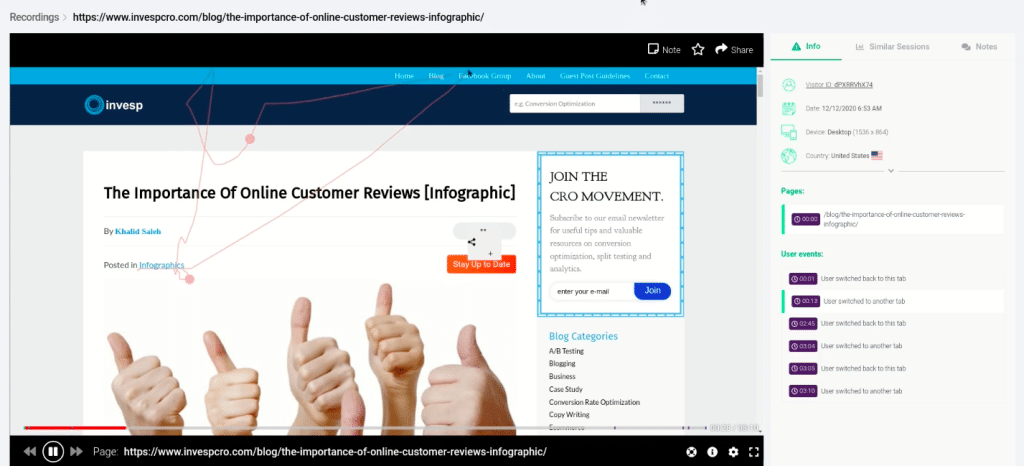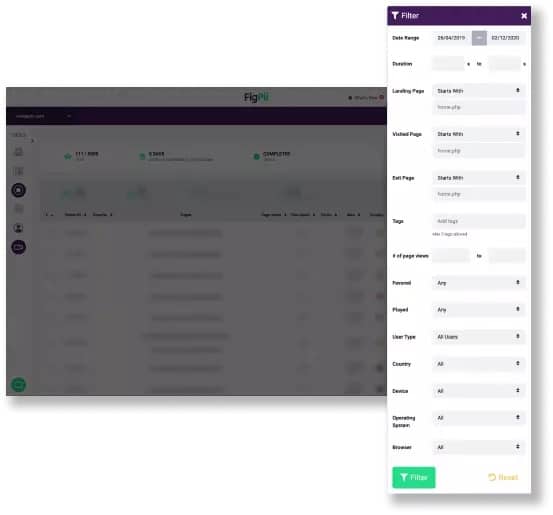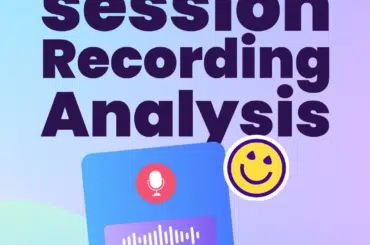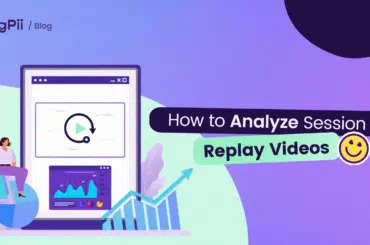Session recordings offer a powerful way to imagine yourself in the customer’s shoes, helping you understand and visualize their experiences.
When you see exactly what they encounter, you can shift your perspective and better align your expectations.
Thanks to modern technology, we can now use these tools to deliver superior-quality products and services, all while gaining deep insights into the customer journey from the moment they start interacting with your product.
What Are Session Recordings?
Session recordings are comprehensive visual representations that capture every customer interaction with a product or service from the moment they start using it.
These recordings detail all customer touchpoints and actions, integrating various deterministic metrics to provide a full picture of the user experience.
This allows companies to analyze behaviors, identify pain points, and improve their offerings based on real user data.
Since users are the most significant patrons of a service or product, companies must understand what they like and dislike. Session recordings help provide precious qualitative data about users’ usage patterns.
While web analytics tools and metrics allow you to visualize the “what” part of the problem, a session replay lets you revisit the “why” part.
WiderFunnel’s Michael St. Laurent opined, “Session replays provide incredibly in-depth insights. In fact, they often offer the easiest, most cost-efficient way to get into the minds of your customers.”
In summary, session recordings provide an “over-the-shoulder” glance into user behavior that companies require to create flawless user experiences, aligning business and IT with a singular view and source of digital truth.
One should not assume that a session recording means simply recording browsing sessions or video recording the customer’s actions.
Session recordings go way beyond mere visitor recordings.
It deconstructs the user’s actions and reconstructs them so that you can view them uninterruptedly as if they were a movie or a play. The data you get is richer and more meaningful than a quaint visitor recording.
Luckily, many automated software platforms these days are making session recording even more accessible and detailed.
Take FigPii’s sessions recording tool, for instance:

(image)
FigPii session recording tool even allows users to filter sessions. For instance, you can see viewers who entered or exited the site from a specific page.
It shows you exactly how you, the users, interact with your page, including:
- Where did they click
- Their scrolling patterns
- How they navigated from one page to another and more
The tool also shows you all of the user information, such as:
- What device were they using
- When did they come to the site
- Which site did they come from before landing on your site?
You can even look for different session recordings for the same visitor and take notes on the videos.

As a result, session recordings provide the perfect fodder for product managers, UI/UX designers, marketers, and developers to consider and build better and more appealing products that more efficiently solve customers’ problems.
How do Session Recordings work?
Imagine you’re watching a video replay of a driver’s journey in a car—the twists and turns, the stops and starts, and even the smaller actions like adjusting the radio or the mirrors. This is similar to what session recordings do for websites.
At the core of session recordings is something similar to the structure of a car but for websites. It’s called the Document Object Model, or DOM. Think of the DOM as the framework of a car—every part, like the windows, doors, and engine, corresponds to parts of a website, like text boxes, images, and buttons.
Here’s how it all comes together:
-
Every Visit is Unique: Just as every drive is different, every visit to a website is unique. The DOM changes with each visitor’s actions, like clicking a link or filling out a form.
-
Capturing the Journey: As a visitor navigates a website, every interaction—every click, every scroll—is recorded, just like a camera capturing every driver’s move. These are called “events.”
-
Recreating the Experience: Later, you can play back these recordings to see exactly what the visitor did, in the order they did it, almost like watching a movie of their journey through the website.
-
The Setting: Just as a car journey happens on roads and streets, online actions happen in a particular setting on the website. This setting is made up of “assets” like images and videos, which help you understand where each action took place.
When you watch these session recordings, you can see just what visitors clicked and how they interacted with the website very humanly—providing insights that simple numbers and data points, like how many people visited a page, cannot.
This video demonstrates the process of selecting and watching a session recording on FigPii. First, a specific session is chosen from the list.
Then, various filters are applied to narrow down the sessions based on specific parameters, such as user behavior or page interactions.
Once the filters are set, you can watch the recorded sessions that meet these criteria, providing a focused insight into user interactions on the website
How do you Analyze Session Recordings?
Analyzing session recordings can be challenging, especially if you have a lot of sessions to watch. Deciding how many videos to watch and what to focus on while watching hours-long recorded interactivity can be challenging.
How do you analyze and make the most of your session recordings?
-
Define Goals
Before you dive into hours-long videos of user interactions with your product, always ensure you define what you hope to achieve from the sessions.
Defining goals gives you a laser focus while reviewing the recording, as you already know what you’re looking for.
If you don’t define goals before watching session recordings, you’ll be watching randomly, which could waste time.
For example, data from your analytics tool can point to multiple problems on your landing page, resulting in high bounce or low conversion rates. When watching your session recording, your goal could be to uncover issues with the landing page.
Having clearly defined goals before watching hours-long of session recordings makes the task a little less daunting.
-
Integrate Quantitative Metrics
Before watching individual recordings, examine aggregated data such as heatmaps, click-through rates, and scroll depths on the pages you are focusing on.
This step can help pinpoint sessions that may reveal the most about user behavior anomalies or drop-offs, providing a data-driven starting point for deeper analysis.
-
Filter Sessions
To make the most out of your session replay, think about the recordings in terms of two things.
- What page or element you’re trying to optimize or improve on your site
- Users groups
For example, if you have many session recordings that focus on your homepage, choose at least ten recordings for the homepage, and for each recording, pick different user groups.
So, it’s like choosing a session that focuses on a specific section of your site or a user problem, and then you’re picking different user groups.
User groups can be chosen based on first-time visits, logged-in, mobile/desktop visitors, and demographic factors such as interests, age, gender, etc.
This way, you’re not just watching the recordings randomly, and you’re more likely to save time while making the most out of the videos that you have.
Most session recording tools allow you to filter your recordings using the available filter feature. This feature helps you focus on the essential recordings for analysis.
Based on the goals you have set for watching session recordings, you should be able to segment and filter the recordings based on criteria such as
- Landing pages
- Pages visited
- Session duration
- Cart abandonments
- Guest Users/Previous Users
- Converted Sessions
- Demographics
- Logged-in users
You can choose the different segmentation types or filters depending on the type of website or products and services you offer customers.
Segmenting your session recordings will help you narrow down and easily find what you’re looking for, which is a step toward your goal.
-
Look out for patterns in user behavior.
When you start watching session recordings, the user behavior might seem random initially, but patterns will likely emerge if you examine them closely and watch more videos.
These emerging patterns will reveal areas of your site that visitors are having problems with and help you understand the thinking behind user behavior.
-
Implement a Structured Review Process
Although we recommend looking for patterns while watching session recordings, confirmation bias can easily start painting patterns that are not necessarily there because of certain beliefs you already have.
Another problem confirmation bias can cause is making you dismiss obvious patterns because they do not conform to your ideas of what a “pattern” should be.
Develop a structured review process where different team members analyze the same session independently and then convene to discuss their findings. This can minimize personal bias and allow for a more comprehensive understanding of user behavior.
-
Prioritize Issues and Plan Iterations
Once you’ve identified patterns and potential usability issues through session recordings, the next step is prioritizing these issues and planning for iterative improvements.
Here’s how you can effectively organize this process:
-
Categorize Issues
- Critical Issues: These are problems that significantly hinder user experience or functionality, such as bugs that prevent users from completing actions or severe navigation issues that lead to high dropout rates.
- Major Issues include less critical but still important usability problems, such as confusing content or suboptimal layout of key elements, which can deter users but don’t completely stop them.
- Minor Issues: These are surface-level issues that don’t significantly impact the user experience, like minor visual inconsistencies or optional enhancements that could potentially increase user engagement.
-
Assess the Impact on User Experience and Business Goals
- Evaluate how each identified issue affects the user experience. Consider factors like increased effort, confusion, or frustration for users.
- Determine the potential impact on business goals, such as conversion rates, retention rates, or overall satisfaction. Use data from analytics to support this assessment.
-
Set Priorities Based on Impact and Resources
- Prioritize issues based on their impact and the resources required to resolve them. High-impact issues that align closely with business goals should generally be addressed first.
- Consider the cost, technical feasibility, and time required to fix each issue, and balance these against the expected benefits.
-
Plan Iterative Tests
- A/B Testing: For issues where multiple solutions are viable, plan A/B tests to determine which changes most effectively improve user experience and meet business objectives. For example, if a checkout process is problematic, you might test different designs or workflows to see which leads to higher completion rates.
- User Feedback Sessions: Schedule sessions where you can gather direct feedback from users about specific changes. This can be particularly useful for understanding subjective elements like design and content.
- Prototype Testing: Before fully implementing changes, use prototypes to test interactions and new designs in a controlled environment, gathering early feedback and making adjustments as necessary.
-
Implement and Monitor
- Roll out changes in stages, starting with the highest priority fixes. Use feature flags or phased rollouts to carefully manage the release of new updates.
- Monitor the impact of each change through analytics and further session recordings. This ongoing monitoring helps you verify the effectiveness of your solutions and further refine your approach as needed.
-
Document and Communicate Changes
- Keep detailed records of what changes were made, why they were made, and the results of those changes. This documentation is vital for understanding the impact over time and communicating with different teams.
- Share updates and outcomes with all relevant stakeholders, including management, the product team, and customer support, to ensure everyone understands the improvements and can effectively relay this information to customers.
Importance of Session Recordings
Session recording tools, just like any other web analytics tool, aim to solve real-world business problems.
Let’s look at some of them:
1. They help discover product bugs
Watching session recordings is highly effective for discovering product bugs by allowing you to see exactly how users interact with your product.
As users navigate your site, these recordings capture any issues they encounter in real-time.
This direct observation helps you quickly identify and understand bugs that might not be apparent through automated testing, especially those that occur under specific user conditions or sequences of actions.
2. Uncover Conversion Hurdles
These tools visually capture where users face obstacles on a website, such as problematic navigation or ineffective calls to action.
Think of watching a user struggle to find the checkout button because it blends too much with the page background.
Analyzing these recordings helps refine marketing strategies and optimize landing pages, significantly boosting conversion rates.
3. Improve Customer Experience
Session recordings provide a clear pathway to enhancing customer experience by revealing exactly how users interact with your website or application.
When customers report vague issues like “the tool is not working,” it can be challenging for support teams to diagnose the problem without specifics.
When you watch the recorded sessions, you can see the exact sequence of actions that led to the issue, allowing you to understand and resolve the problem more quickly and accurately.
This direct insight helps make precise adjustments to the user interface or functionality, thereby preventing future complaints and improving the overall customer service experience.
4. Identify User Frustration Points
Imagine a scenario where users are attempting to complete a multi-step registration process on your website, but the form resets unexpectedly due to a timeout error.
This leads to repeated entries and significant user frustration, potentially causing users to abandon the process entirely.
Session recordings can pinpoint these critical moments, revealing when and where users experience frustration.
5. Legal Business Evidence
In cases of disputes, such as a customer claiming they were misled by website information, session recordings can provide concrete evidence showing exactly what the user saw and interacted with during their visit.
This can be useful in legal scenarios, offering clear-cut evidence that supports the company’s position.
6. Dynamic Web Application States And Client Interactions
Session recordings can reveal how users interact with dynamic elements like modals and accordions. Imagine a user trying to close a modal window that doesn’t have a clear “close” button, leading to frustration.
Understanding these interactions is crucial for improving website functionality and ensuring a seamless user experience.
As a company, you must be on the lookout to upgrade and revamp your customer experience. The focus must be on providing value to customers and solving business problems.
All the above pointers aim to do just that. This improves your business’s bottom line, which ultimately helps your company survive.
How to Find the Right Session Recording Tool
Session recordings identify and resolve challenges across industries. Their applications span multiple business verticals and can vary extensively.
While the exact features that companies look for in this tool closely relate to the relevant industry, some of them are important across business horizontals.
Let’s take a look at some of the features that you should consider while looking for a session recording software solution:
1. Session Filtering
A session recording tool captures many sessions across multiple user journeys. When analysts analyze the data, they look for an excellent filter that enables them to extract the relevant sessions.
While not every tool provides a filtering option, this feature is essential, especially when you have many sessions. Hotjar and FigPii are two great examples.
Here’s an example of FigPii’s extensive filtering options:

2. Performance
Most session recording tools are high-tech and have the latest proprietary software embedded. This software works at the tool’s backend to capture data related to the website or application. Depending on the software, the website’s speed will vary.
Thus, choosing a high-performance, speedy tool like FigPii or Fullstory with minimal loading time makes sense.
2. Data Retention
The tools capture a lot of data over time. The more data, the deeper the insights generated. The real problem is retaining it over time. While some tools, like Dynatrace, provide retention periods of up to years, some may store it for hours, days, weeks, or months. Choose a tool whose data retention policy matches your requirements.
3. Caching
A caching feature helps store previous search requests and results in a browser-centric manner. This helps speed up the loading times for future requests. While some session recording tools cache assets like images, CSS, and HTML, many do not. This is an important consideration when choosing the right tool.
4. Form Analytics
Businesses need to know why their customers are abandoning their websites or not renewing their subscriptions. It helps them take timely corrective measures and is a feature aimed at customer retention. For example, Mouseflow provides a great form analytics attribute that helps companies find out the reason for abandonment.
5. Sampling Extent
Most tools capture all the user’s sessions. However, some capture only a sample set from the entirety. While this is a great way to save memory, it also needs a bit of luck.
If the session you are looking for does not fall under the sampling set, you will miss it. Tools that perform sampling can restrict its utility.
It makes sense if you are working on a small project under a tight budget. However, if the project is a major one, you should choose a tool that captures entire sessions, like Fullstory and FigPii.
6. User-Friendliness
Your own developers should be able to adapt to the session recording tool quickly and accept it as an integral part of your customer research process.
Just as your customers will not use a software tool that is not intuitive, your employees will also denounce a tool with a steep learning curve. Therefore, when choosing a tool for your engineers, ensure it is user-friendly and easy to use.
Research the tools before making a purchase. It is a one-time investment that will cost money if it is scrapped because it is difficult to handle. Crazy Egg, LiveSession, and FigPii are great examples.
7. Pricing Plans
No matter how big a company you are or how important the project is, pricing is always a decisive factor in choosing the right tool.
The price of session recording tools can vary based on factors like data retention, ability to capture graphics and animation, sampling, language capabilities, and more. If you are looking for basic features, there are many great free tools like Plerdy and Crazy Egg.
That said, if you want more characteristics and facets, it is best to get a paid plan.
Conclusion
Today’s technology allows us to mirror a customer’s online journey through session recordings, going beyond traditional web analytics.
While metrics such as click-through rates, bounce rates, and conversion rates offer valuable insights, they do not provide a deeply personalized view of user interactions.
Session recordings bridge this gap by offering a visual narrative of the customer’s experience, allowing us to see beyond numbers and charts.
This approach helps identify what works and what doesn’t and uncovers nuanced insights into potential deal-breakers that traditional metrics might miss.
Session Recordings FAQs
What is the meaning of Session Recordings?
Session recordings are detailed captures of user activities on a website or application, tracking everything from clicks to keystrokes and providing insights into user behavior for enhanced experience optimization.
What are the challenges associated with session recording?
- Data Volume: Significant resources are required to manage and analyze large data sets.
- Privacy Concerns: Protecting user privacy in session recordings necessitates strict data handling.
- Performance Impact: Session recordings can slow down website performance.
- Bias in Data: These recordings can produce biased insights if not diversely sampled.
- Complex Analysis: Effective analysis of session recordings requires advanced expertise.
- Storage and Security: Securing recorded data against unauthorized access is challenging.
How do session recording tools integrate with Digital Analytics tools?
Session recording tools complement digital analytics by adding a qualitative layer to these tools’ quantitative data. While analytics tools measure metrics like clicks and interactions, session recordings reveal the user behaviors behind these numbers.



